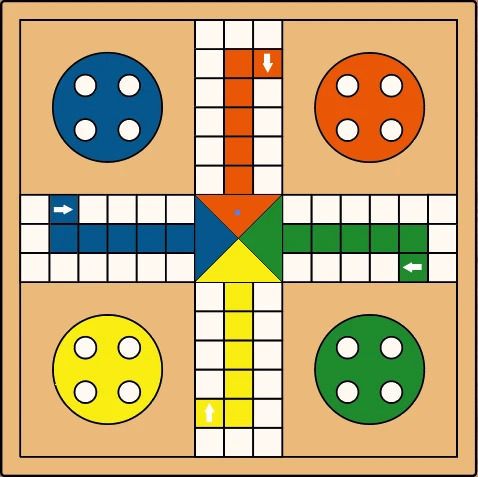Ludo
Ludo consists of a square board with four different colored bases in each corner. The first colored space outside of each base is the start position. A path leads clockwise around the board returning to a path with the same color as the base, then to the home column, which leads to the center home triangle.
There are four different colored sets of playing pieces that start off in their matching bases. Each set consists of 4 playing pieces. The included die is used to govern the movement of the pieces.
2 to 4 players begin by placing their respective pieces in their bases. Each takes turns throwing the die, and the player with the highest roll plays first. The players to the left follow in turn going clockwise. On each player’s turn, the player rolls the die to determine a move. The goal of the game is to move all four of the player’s pieces clockwise once around the board, up the home column, and into the home triangle.
Movement
To begin, a player must roll a six to move a piece out of the base and onto the start position. That piece is then in play. The player cannot make any other moves until at least one piece is in play.
If a player has a piece or pieces in play, they can move any one of their pieces 1 to 6 spaces along the path according to the number they roll.
Rules of the 6’s.
- If a six is rolled, the player can choose to either move a piece out of his base onto the start position or move a piece that is in play.
- Anytime a six is rolled, the player gets an extra roll after his move.
- If a six is rolled three times in a row, the player loses his turn.
Landing on a shared square
If a player’s piece lands on an opponent’s piece, the opponent’s piece is sent back to their base where he must roll a six again in order move it out onto the starting square.
If a player lands on a space occupied by one of his own pieces, that space becomes blocked. A blocked space cannot be passed or landed on by an opponent’s piece.
Winning the Game
When a player’s piece has reached the home column of its own color, the piece continues its moves toward the center to its home triangle. When a player’s die roll lands its piece on the home triangle, that piece has completed its journey. A piece can only be moved to the home triangle with an exact roll.
The first player to have all four of his pieces finish their journeys wins. The remaining players continue the game to determine the runner-ups.





